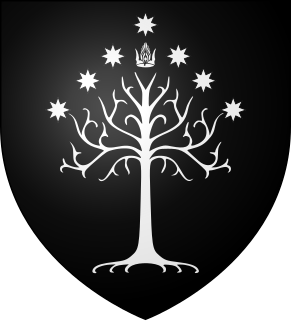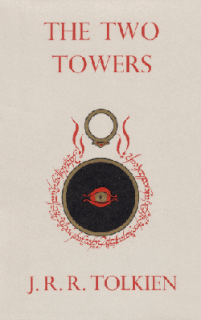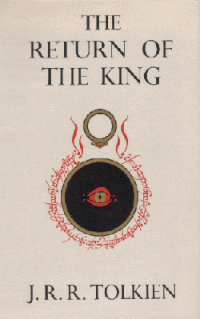Related Research Articles
Denethor II, son of Ecthelion II, is a fictional character in J. R. R. Tolkien's The Return of the King, which is the third and final part of his novel The Lord of the Rings. He is the 26th Ruling Steward of Gondor.
Boromir is a fictional character in J. R. R. Tolkien's legendarium. He appears in the first two volumes of The Lord of the Rings, and is mentioned in the last volume, The Return of the King. He was the heir of Denethor II and the elder brother of Faramir. In the course of the story Boromir joined the Fellowship of the Ring.

Gondor is a fictional kingdom in J. R. R. Tolkien's writings, described as the greatest realm of Men in the west of Middle-earth by the end of the Third Age. The third volume of The Lord of the Rings, The Return of the King, is largely concerned with the events in Gondor during the War of the Ring and with the restoration of the realm afterward. The history of the kingdom is outlined in the appendices of the book.
A palantír is a fictional magical artefact from J. R. R. Tolkien's Middle-earth legendarium. A palantír is described as a crystal ball, used for both communication and as a means of seeing events in other parts of the world or in the distant past or in the future.

The Two Towers is the second volume of J. R. R. Tolkien's high fantasy novel The Lord of the Rings. It is preceded by The Fellowship of the Ring and followed by The Return of the King.

The Return of the King is the third and final volume of J. R. R. Tolkien's The Lord of the Rings, following The Fellowship of the Ring and The Two Towers. The story begins in the kingdom of Gondor, which is soon to be attacked by the Dark Lord Sauron.
Minas Tirith is a fictional city in J. R. R. Tolkien's Legendarium. It became the heavily fortified capital of the kingdom of Gondor in the second half of the Third Age. It had originally been built to guard the former capital, Osgiliath, from attack from the west, but became the capital when Osgiliath fell into ruin following the Kin-strife and the Great Plague.
In the fictional high fantasy-world of J. R. R. Tolkien, the War of the Ring was fought between Sauron and the free peoples of Middle-earth for control of the One Ring and dominion over the continent. The War of the Ring took place at the end of the Third Age. Together with the Quest of Mount Doom, it is one of the overarching events of The Lord of the Rings. Gandalf and Elessar Telcontar led the free peoples of Middle-earth to victory over the Dark Lord.

The Lord of the Rings: The Return of the King is a 2003 epic fantasy adventure film directed by Peter Jackson, based on the third volume of J. R. R. Tolkien's The Lord of the Rings. The film is the third instalment in The Lord of the Rings trilogy and was produced by Barrie M. Osborne, Jackson and Fran Walsh, and written by Walsh, Philippa Boyens and Jackson. The film features an ensemble cast including Elijah Wood, Ian McKellen, Liv Tyler, Viggo Mortensen, Sean Astin, Cate Blanchett, John Rhys-Davies, Bernard Hill, Billy Boyd, Dominic Monaghan, Orlando Bloom, Hugo Weaving, Miranda Otto, David Wenham, Karl Urban, John Noble, Andy Serkis, Ian Holm, and Sean Bean. It was preceded by The Fellowship of the Ring (2001) and The Two Towers (2002).

Minas Morgul also known by its earlier name of Minas Ithil is a fictional fortified city in J. R. R. Tolkien's Middle-earth.
In J. R. R. Tolkien's Legendarium, the Battle of the Pelennor Fields [pɛˈlɛnnɔr] is the battle for the city of Minas Tirith between the forces of Gondor and its allies, and the forces of the Dark Lord Sauron. Tolkien recounts this battle in The Return of the King, the third volume of his 1954–55 novel The Lord of the Rings as originally printed. It is the largest battle and one of the most important events of the War of the Ring, the war in which the Third Age of Middle-earth comes to a close. It takes place on 15th 'March' T.A. 3019 in the Pelennor Fields, the townlands and fields between Minas Tirith and the River Anduin. The concept and history of composition of the battle is detailed in the fourth volume of The History of the Lord of the Rings.

In J. R. R. Tolkien 's (fictional) legendarium, Dol Amroth was a hill along the coast of Gondor, on a peninsula on the Bay of Belfalas; and also the city that grew up there, mainly in the Third Age as the seat of the principality of the same name. The Prince of Dol Amroth was one of the principal subjects of Gondor. In The Lord of the Rings, Prince Imrahil is the Prince of Dol Amroth, a supporting character in the book's third volume, The Return of the King.
This article includes several chronologies relating to J. R. R. Tolkien's legendarium.
In J. R. R. Tolkien's legendarium, the Battle of the Morannon or Battle of the Black Gate is a fictional event that took place at the end of the War of the Ring. It is depicted in The Return of the King, the third volume of his epic fantasy book The Lord of the Rings.
"A Walking Song" is a poem in the form of a song from J. R. R. Tolkien's fantasy novel The Lord of the Rings, originally published in three volumes. It appears in the third chapter of the novel, entitled "Three is Company"; usually as part of the first volume, The Fellowship of the Ring. It is given its title in an index to songs and poems usually published in the third volume, The Return of the King.

The Last Ringbearer is a 1999 fantasy book by Russian author Kirill Eskov. It is an alternative account of, and an informal sequel to, the events of J.R.R. Tolkien's The Lord of the Rings.
In J. R. R. Tolkien's Middle-earth legendarium, Faramir is a fictional character appearing in The Lord of the Rings. He is introduced as the younger brother of Boromir of the Fellowship of the Ring and second son of Denethor II, the Steward of the realm of Gondor. The relationships between the three men are revealed over the course of the book and are elaborated in the appendices.
Peregrin Took, more commonly known simply as Pippin, is a fictional character from J. R. R. Tolkien's fantasy novel The Lord of the Rings. He is closely tied with his friend and cousin, Meriadoc Brandybuck (Merry), and the two are usually together during most of the story. Pippin and Merry are introduced as a pair of young hobbits who become ensnared in fellow hobbit Frodo Baggins's quest to destroy the One Ring. In this regard, Pippin is a member of the Fellowship of the Ring. He and Merry become separated from the rest of the group at the breaking of the Fellowship and spend much of The Two Towers with their own story line. Impetuous and curious, he enlists as a soldier in the army of Gondor and fights in several battles during the War of the Ring. In the epilogues to the main story, Pippin returns to the Shire and becomes Thain or hereditary leader of the land before dying and being buried as a hero in Gondor.
Aragorn II, son of Arathorn is a fictional character from J. R. R. Tolkien's legendarium. He is one of the main protagonists of The Lord of the Rings. Aragorn was a Ranger of the North, first introduced with the name Strider at Bree, as the Hobbits continued to call him throughout The Lord of the Rings. He was eventually revealed to be the heir of Isildur and rightful claimant to the thrones of Arnor and Gondor. He was also a confidant of Gandalf and an integral part of the quest to destroy the One Ring and defeat the Dark Lord Sauron.
References
- ↑ The Lord of the Rings, The Return of the King, Book Five, Chapter 1: "Minas Tirith"
- ↑ The Lord of the Rings, The Return of the King, Book Five, Chapter 4:"The Siege of Gondor"
- 1 2 The Lord of the Rings, The Return of the King, Book Five, Chapter 8:The House of Healing
- ↑ The Lord of the Rings, The Return of the King, Book Five, Chapter 9:The Black Gate Opens
- ↑ The Lord of the Rings, The Return of the King, Book Six, Chapter 6; The Steward and the King
- ↑ The Complete Guide to Middle-earth
- ↑ Drout, Michael D.C. (2006). J.R.R. Tolkien Encyclopedia: Scholarship and Critical Assessment. Routledge. ISBN 978-0-415-96942-0.
- ↑ The History of Middle-earth, Vol. 12: The Peoples of Middle-earth, XVI: "The New Shadow"
- ↑ Croft, Janet B. (2004). War and the Works of J.R.R. Tolkien. Praeger. ISBN 978-0-313-32592-2.
- ↑ Chance, Jane (2001). Lord of the Rings: The Mythology of Power. The University Press of Kentucky. pp. 103–104. ISBN 978-0-8131-9017-4.
- ↑ Wiggins, Kayla McKinney (2007). "The Person of a Prince, Echoes of Hamlet in Tolkien's The Lord of the Rings". In Croft, Janet B.; Palumbo, Donald E.; Sullivan, C.W. (eds.). Tolkien And Shakespeare: Essays on Shared Themes And Language. McFarland & Company. ISBN 978-0-7864-2827-4.
- Tolkien, J. R. R. (1955), The Return of the King , The Lord of the Rings , Boston: Houghton Mifflin (published 1987), ISBN 0-395-08256-0
